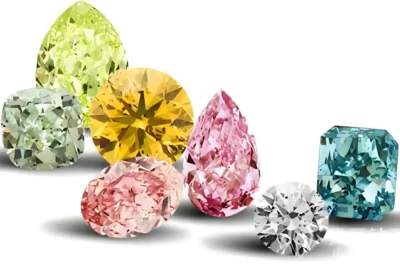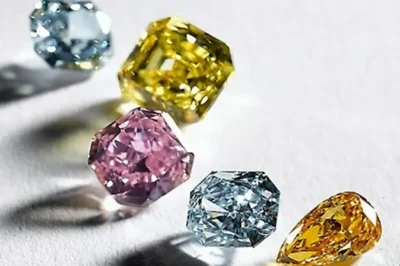Color is one of the most visible and influential aspects of a diamond. Whether you’re a jewelry brand sourcing high-clarity gems or a buyer browsing wholesale catalogs, diamond color directly impacts perceived quality and value. But when it comes to cultured diamond color, the rules change just a bit. While these lab-grown gems are chemically identical to their mined counterparts, their journey through controlled environments opens up exciting possibilities in color manipulation.
What Determines Diamond Color? 
In both natural and cultured diamonds, color arises from impurities or structural irregularities within the crystal lattice. Trace elements like nitrogen (which causes yellow tints) or boron (responsible for blue hues) alter how light interacts with the diamond. A perfect diamond—completely devoid of these elements—will appear colorless.
The GIA Grading Scale: D to Z
The Gemological Institute of America (GIA) rates diamonds on a scale from D (colorless) to Z (light yellow or brown). Most lab-grown diamonds fall between D and J on this scale. However, with ongoing advances in cultured diamond color control, achieving consistently high grades is becoming more feasible.
Why Color Matters to B2B Buyers
Whether you’re in high-end bridal, fashion jewelry, or private-label retail, color is often a non-negotiable criterion. Colorless (D-F) diamonds command premium prices and are favored for luxury collections. Near-colorless (G-J) stones are preferred for value-based offerings. Understanding how color is controlled in cultured diamonds helps B2B buyers make informed sourcing decisions and elevate their brand standards.
Sources of Color in Cultured Diamonds
The methods used to create lab-grown diamonds have a direct effect on their coloration. There are two primary growth processes: Chemical Vapor Deposition (CVD) and High Pressure High Temperature (HPHT). Each has distinct color implications.
CVD vs HPHT: Which Affects Color More?
- CVD diamonds often show brown, gray, or yellow tints due to lattice distortion and the presence of nitrogen.
- HPHT diamonds, on the other hand, are typically grown in an environment with higher control over nitrogen and pressure, often producing clearer stones right from the start.
Common Tints in CVD Diamonds
While CVD is popular for scalability and cost-efficiency, it has historically produced diamonds with slight tints. Brownish undertones are common due to vacancies in the carbon lattice. These colorations are not permanent, however—they can often be corrected post-growth.
Why Early Lab Diamonds Were Mostly Tinted
The first waves of cultured diamonds were created with limited control over environmental conditions. Nitrogen levels weren’t precisely regulated, and pressure-temperature ratios varied widely. These factors led to a higher percentage of yellow or brown-tinted diamonds. Today, that has changed significantly.
Technological Innovations in Color Control
Thanks to ongoing R&D, controlling cultured diamond color is no longer guesswork. Modern production integrates sophisticated systems that monitor and adjust every phase of the growth and post-growth cycle.
Advanced CVD Techniques
CVD color control has evolved immensely. Here’s how:
- Gas Purity: Oxygen, hydrogen, and methane gases used in CVD reactors are now ultra-purified to eliminate trace elements.
- Chamber Cleanliness: Contamination from prior batches is minimized through vacuum purging and cleaning cycles.
- Nitrogen Suppression: The growth process is managed in low-nitrogen or nitrogen-free environments to reduce yellow coloration.
These improvements result in diamonds with higher clarity and lighter color right out of the reactor.
Post-Growth HPHT Treatment
One of the most powerful tools in cultured diamond color enhancement is post-growth HPHT treatment. Here’s how it works:
- The diamond is placed under extremely high pressure and temperature—replicating the natural formation environment.
- These conditions help “heal” the crystal lattice, removing color centers and reducing tint.
- Brown or yellow tones can be transformed into near-colorless or even D-grade stones.
Irradiation and Annealing (Legacy Methods)
These methods were more common a decade ago but are now less preferred:
- Irradiation: Alters the color by bombarding the diamond with particles.
- Annealing: Uses heat to stabilize or shift color.
- While effective, these approaches often raise concerns around durability and long-term color stability, and they typically require disclosure to the buyer.
Material Science Behind Color Improvement
Understanding cultured diamond color isn’t just about machines and processes. It’s also deeply rooted in chemistry and physics.
Lattice Defects and Vacancies
Every diamond’s atomic structure can have imperfections called vacancies. These can absorb specific wavelengths of light, leading to unwanted color. Color control innovations focus on reducing these defects through:
- Ultra-pure carbon sources
- Stable temperature gradients
- Slow, even growth cycles
How Trace Elements Influence Color
- Nitrogen: The primary culprit behind yellow diamonds. Even tiny amounts can shift a diamond down the color scale.
- Boron: Causes blue hues. While rare, it’s desirable in some fancy colors.
Managing trace elements at the atomic level is key to achieving colorless cultured diamonds.
Achieving D-F Grades: The Holy Grail
Today’s labs can now achieve D, E, and F grades at higher consistency than ever before. With improved control during growth and refined post-growth treatments, manufacturers are increasingly able to produce diamonds that rival the best mined stones.
Research and Patents Driving Innovation
Behind the scenes, there’s an explosion of patents and research papers focused on cultured diamond color optimization:
- Gas composition algorithms
- AI-monitored crystal growth
- Carbon feedstock purification systems
These are all quietly powering the next wave of color-perfect diamonds.
Market Impact of Colorless Lab-Grown Diamonds
With color control improving rapidly, the cultured diamond market is shifting.
Changing Consumer Preferences
Today’s shoppers are more educated than ever. They want:
- Brilliant, colorless diamonds at better price points
- Ethical sourcing and transparency
- Long-lasting clarity without compromise
Colorless cultured diamonds deliver on all three fronts.
Boosting Brand Perception
For jewelers, offering D-F color diamonds in a lab-grown format allows:
- Stronger luxury positioning
- Higher customer trust
- Better online visual appeal (important for eCommerce)
Pricing Tiers and Value Perception
Color plays a huge role in pricing:
- D-F (Colorless): Premium tier
- G-J (Near-colorless): Mid-tier
- K-Z (Faint color): Budget and experimental jewelry
With better control, manufacturers can target these tiers strategically.
Investment Appeal
As color control becomes more standardized, lab-grown diamonds are entering the luxury investment conversation. D-color cultured diamonds, once rare, are now more widely available and seen as reliable assets by certain investors.
Implications for B2B Buyers and Jewelry Brands
If you’re a buyer sourcing lab-grown diamonds, the improvements in color control open several strategic doors.
Customizing Orders by Color Grade
Manufacturers can now:
- Tailor batches to D-F, G-H, or I-J grades
- Ensure batch consistency
- Support special projects with controlled hues
Supply Chain Transparency
With blockchain and digital certification tools, color information is verifiable and traceable. This transparency reduces returns, increases buyer confidence, and ensures compliance with labeling regulations.
Private Labeling Opportunities
Color control makes it easier to offer private-label lines with consistent visual identity. Your brand’s “signature look”—whether icy-white or slightly warm—can be reliably repeated.
Reduced Waste, Higher Yield
In the past, a significant number of CVD diamonds required color correction or were downgraded. Today, optimized processes mean higher yields of saleable stones and reduced post-processing costs.
Comparison: Natural vs Cultured Colorless Diamonds
Colorless cultured diamonds are now so well-made that many consumers can’t tell the difference. But there are subtle distinctions worth noting.
Visual Differences
To the naked eye? None. Even gemologists often need advanced tools to detect whether a D-color diamond is lab-grown or mined.
Spectroscopic Testing
Devices like photoluminescence spectrometers and UV testing can identify growth patterns that distinguish lab-grown from mined stones.
Certification Clarity
Most grading labs now include origin (natural or lab-grown) along with color and clarity grades. Certifications from IGI and GIA make it easy for buyers to confidently market their products.
Market Acceptance
The stigma around lab diamonds is disappearing fast. Especially with colorless options, many luxury consumers now prefer lab-grown for both ethics and affordability.
Future Directions in Cultured Diamond Color Technology
The road ahead looks even brighter—literally. New innovations are pushing cultured diamond color into uncharted territory.
AI and Smart Growth Chambers
Some manufacturers are integrating AI to:
- Monitor crystal defects in real-time
- Adjust pressure and temperature automatically
- Predict color outcomes before growth completes
Blockchain Traceability for Color
Incorporating digital ledgers to log:
- Color grade upon completion
- Treatments used
- Chamber specifications
This level of transparency appeals to both consumers and regulators.
On-Demand Color Customization
Want a G-color diamond with perfect symmetry and VVS1 clarity? Soon, you might be able to order it like customizing a smartphone. Controlled environments make this possible.
Fancy Colors, But Controlled
Beyond colorless, producers are now exploring controlled production of fancy pinks, blues, and even greens. That means:
- More consistent hues
- Better market pricing
- Greater artistic freedom for designers

Frequently Asked Questions (FAQ)
What makes cultured diamonds yellow?
Yellow tones typically come from nitrogen impurities or growth inconsistencies in the diamond’s crystal lattice.
Can a yellow cultured diamond become colorless?
Yes. Through HPHT post-treatment or refined CVD growth processes, yellow-tinted diamonds can often be improved to near-colorless or colorless.
Are colorless lab-grown diamonds real diamonds?
Absolutely. They have the same chemical and physical properties as mined diamonds.
Is D color possible in cultured diamonds?
Yes, and it’s becoming increasingly common with today’s precise color control technologies.
How do manufacturers control color during diamond growth?
By regulating temperature, pressure, gas purity, and growth duration—and applying post-growth HPHT treatment when needed.
Final Thoughts: Why Color Control Is the Future of Cultured Diamonds
The era of yellow-tinted lab diamonds is over. Today, cultured diamond color is a precise science. Brands can now access D-F color diamonds with greater reliability, cost-efficiency, and transparency than ever before.
As consumer expectations rise and sustainability takes center stage, the ability to produce consistent, colorless lab-grown diamonds will define the next generation of high-end jewelry.
Now is the perfect time to embrace the brilliance of color-controlled cultured diamonds—and offer your customers a sparkle that truly shines.






